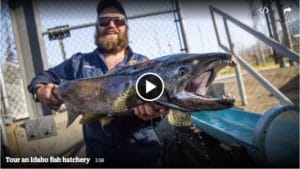We paid $14 million for a fish hatchery . . . and all its fish are dying
Idaho Statesman reporter, Rocky Barker’s latest installment examining the struggle to restore salmon and steelhead populations on the Snake and Columbia rivers. You might also enjoy Rocky’s earlier installments, which follow.
The public paid $14 million for an Idaho hatchery — and all its fish have been dying
Only 157 endangered Snake River sockeye salmon returned to the Sawtooth Valley this year — and not one of them came from a $14 million hatchery built to help their recovery.
The Springfield Hatchery opened in eastern Idaho in 2013, paid for by the Bonneville Power Administration, whose ratepayers provide a major source of funding for regional salmon recovery. It was designed to add up to 1 million more sockeye that could be released into Redfish Lake Creek near Stanley. But Idaho Department of Fish and Game biologists discovered the young salmon smolts have been dying after their release because of stress.
A Year of Rocky Barker on the Snake and Columbia Rivers

Without the dams would salmon populations recover?

Should Snake dams be removed? Here’s what first changed Statesman editorial board’s mind.

Northwest salmon still struggle to survive. Can we save them — and at what price?
There still is no sustainable plan for saving salmon, and the changing climate will put even more stress on remaining fish stocks.
Fate of Pacific Northwest orcas tied to having enough Columbia River salmon
The connection between saving salmon in the Columbia and Snake rivers and preserving killer whales in Washington state and British Columbia is bringing together advocates of both imperiled species, who want to see four Snake River dams in Washington removed.

